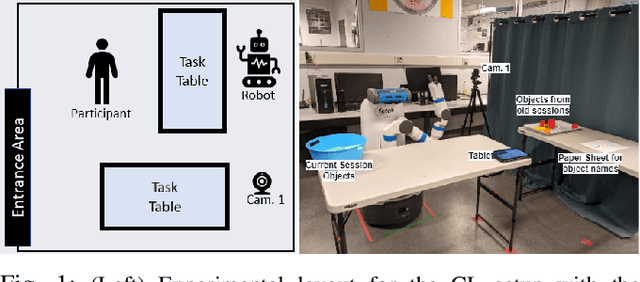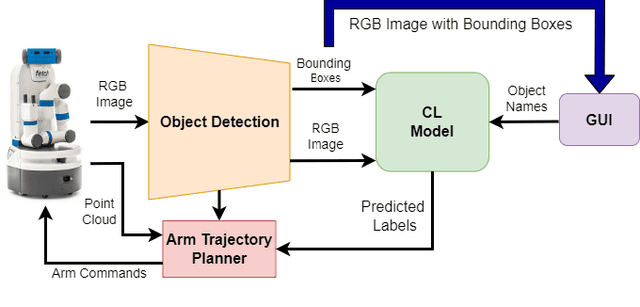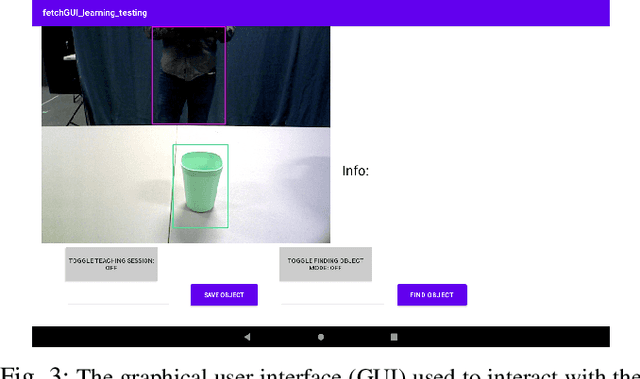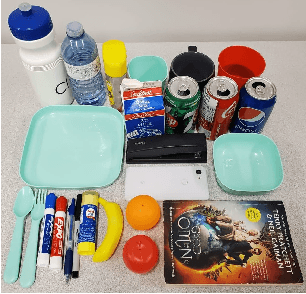Zachary De Francesco
How Do Human Users Teach a Continual Learning Robot in Repeated Interactions?
Jun 30, 2023



Abstract:Continual learning (CL) has emerged as an important avenue of research in recent years, at the intersection of Machine Learning (ML) and Human-Robot Interaction (HRI), to allow robots to continually learn in their environments over long-term interactions with humans. Most research in continual learning, however, has been robot-centered to develop continual learning algorithms that can quickly learn new information on static datasets. In this paper, we take a human-centered approach to continual learning, to understand how humans teach continual learning robots over the long term and if there are variations in their teaching styles. We conducted an in-person study with 40 participants that interacted with a continual learning robot in 200 sessions. In this between-participant study, we used two different CL models deployed on a Fetch mobile manipulator robot. An extensive qualitative and quantitative analysis of the data collected in the study shows that there is significant variation among the teaching styles of individual users indicating the need for personalized adaptation to their distinct teaching styles. The results also show that although there is a difference in the teaching styles between expert and non-expert users, the style does not have an effect on the performance of the continual learning robot. Finally, our analysis shows that the constrained experimental setups that have been widely used to test most continual learning techniques are not adequate, as real users interact with and teach continual learning robots in a variety of ways. Our code is available at https://github.com/aliayub7/cl_hri.
Continual Learning through Human-Robot Interaction -- Human Perceptions of a Continual Learning Robot in Repeated Interactions
May 22, 2023Abstract:For long-term deployment in dynamic real-world environments, assistive robots must continue to learn and adapt to their environments. Researchers have developed various computational models for continual learning (CL) that can allow robots to continually learn from limited training data, and avoid forgetting previous knowledge. While these CL models can mitigate forgetting on static, systematically collected datasets, it is unclear how human users might perceive a robot that continually learns over multiple interactions with them. In this paper, we developed a system that integrates CL models for object recognition with a Fetch mobile manipulator robot and allows human participants to directly teach and test the robot over multiple sessions. We conducted an in-person study with 60 participants who interacted with our system in 300 sessions (5 sessions per participant). We conducted a between-participant study with three different CL models (3 experimental conditions) to understand human perceptions of continual learning robots over multiple sessions. Our results suggest that participants' perceptions of trust, competence, and usability of a continual learning robot significantly decrease over multiple sessions if the robot forgets previously learned objects. However, the perceived task load on participants for teaching and testing the robot remains the same over multiple sessions even if the robot forgets previously learned objects. Our results also indicate that state-of-the-art CL models might perform unreliably when applied to robots interacting with human participants. Further, continual learning robots are not perceived as very trustworthy or competent by human participants, regardless of the underlying continual learning model or the session number.
 Add to Chrome
Add to Chrome Add to Firefox
Add to Firefox Add to Edge
Add to Edge